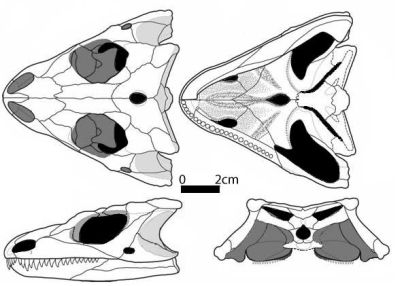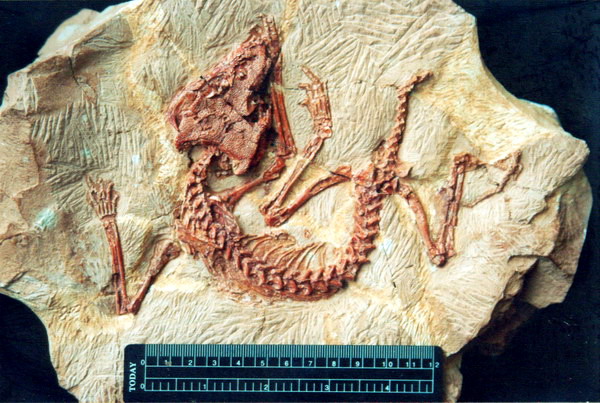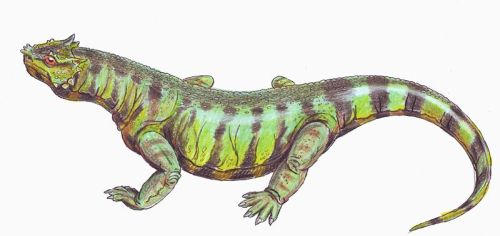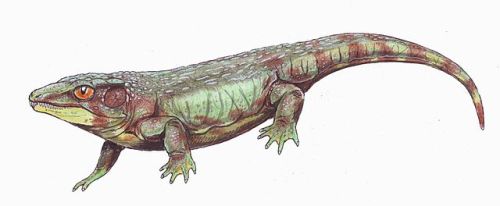Nycteroleteridae
Taxa on This Page
- Emeroleter X
- Macroleter X
- Nycteroleter X
- Nycteroleteridae X
- Rhipaeosaurus X
Descriptions
Nycteroleteridae Romer, 1956 : Bashkyroleter Emeroleter, Macroleter, Nycteroleter, Rhipaeosaurus, and unnamed newly discovered specimen NM QR3061. (Cisneros & Tsuji 2009)
Phylogeny:
Conventional (cladist): Procolophonia : Nyctiphruretus + Procolophonoidea + (Pareiasauridae + * : Macroleter + Rhipaeosaurus + (Nycteroleter + Emeroleter)
Gradist: Procolophonia : (Nyctiphruretus ::: Procolophonoidea) + * : Macroleter + (Nycteroleter + Emeroleter) + (Rhipaeosaurus ::: Pareiasauridae)
Characters: deeply-incised otic notch, the postparietals entering the pineal foramen, the skull ornamentation composed of regular circular pits, and the row of palatal teeth extending from the interpterygoid vacuity to the lateral margin of the choana. (Lee, 1997 p.203)
Comments: [1] Small-to medium sized parareptiles, combining procolophonoid and pareiasaurid features (Cisneros & Tsuji 2009). Using modern amniotes as analogues, Muller and Tsuji 2007 have argued that Nycteroleterids possessed efficient impedance-matching hearing, suggesting ecological adaptations to dim-light environments. These animals were particularily common and diverse in subtropical CisUral Russia.
[2] Recently a nycteroleter has been found in the Middle Permian Tapinocephalus Assemblage Zone of South Africa, the first record of the family from Gondwana (Cisneros & Tsuji 2009)
[3] Nycteroleterids have variously been described as procolonophoidean reptiles Colbert, 1946; Romer, 1966, Holmes, 1984 and seymouriamorph amphibians (e.g. Heaton, 1980; Milner, 1993). Lee 1995 suggests the amphibians interpretation is due to these animals being reconstructed with an intertemporal, posteriorly-located jaw articulation, and a slit-like, dorsally-located (i.e. 'amphibian') otic notch when they lack these features, and in any case the otic notch, often considered a phylogenetically important feature, has appeared and disappeared repeatedly in tetrapods. Cladistic analysis by Lee 1995 and 1997 instead placed Nycteroleterids with Nyctiphruretus in the new taxon Nyctiphruretia as the sister clade to the both pareiasaurs and procolophonids. More recent studies do not support a monophyletic Nyctiphruretia (Müller & Tsuji 2007, Säilä 2010b). Reisz & Scott 2002 place the basal Nycteroleterid Macroleter as sister taxon of pareiasauridae + procolophonoidea. Muller and Tsuji 2007 found that, apart from Nyctiphruretus, all non-pareiasaurian parareptiles from the Mezen River Basin formed a monophyletic group, which they informally termed the 'nycteroleters,' that was either sister group to the Procolophonia or else sister group to the Pareiasauridae within the Procolophonoidea. Tsuji & Müller 2009, Lyson et al 2010 put the nycteroleterids closer to pareiasaurs. Tsuji et al 2012 using both parsimony and Bayesian inference recovered a monophyletic nycteroleter clade using parsimony, whereas they found the group to be paraphyletic with Bayesian inference ). It's interesting to consider that tree toplogy and the relationship of Archaeopteryx to deinonychosaurs on the one hand and birds on the other likewise various according to methodology used. MAK120324
Links Vyatka Palaeontological Museum MAK120322

Macroleter poezicus Tverdokhlebova and Ivakhnenko 1984 = Tokosaurus perforatus Tverdochlebova & Ivachnenko, 1984
Middle Permian of Russia;
Horizon: Belebey Svita, Upper Kazanian (Roadian/Wordian)
Size: ~8 cm skull length, ~75 cm overall length
Comments: Tokosaurus was a small common, insectivorous amphibious animal. As with Nycteroleter, to which it might be related, there is disagreement over whether this lizard-like animal was a reptile-like amphibian or a primitive reptile. It was also placed in its own family, the Tokosauridae. Recently, Tsuji et al 2012 have shown that Tokosaurus perforatus say that it is a junior synonym of Macroleter poezicus, and the most basal member of the Nycteroleteridae. MAK
References: V.P. Tverdokhlebov et. al. 2005
Graphics Skull of Macroleter poezicus (= Tokosaurus perforatus) © David Peters, used with permission
Nycteroleter ineptus Efremov, 1938
Middle Permian of Russia;
Horizon: Belebei-Mezen Cotylosaur Complex, Lower Tatarian (Roadian/Wordian)
Locality: Mezen River, Arkhangelsk Region, northern European Russia
Comments: Nycteroleter was a small insectivorous, lizard-like animal, found at the same locality as Nyctiphruretus, and traditionally included in the same family. Although similar in form and, perhaps, environment and lifestyle, it differs regarding details of the rear of the skull. For example, Nycteroleter has a deep otic notch and tabulars extending back, these being primitive amphibian features. For this reason it has been suggested that Nycteroleter is actually a reptile-like amphibian, perhaps, like Seymouria, indistinguishable from a true reptile in life. Most authorities however still consider Nycteroleter a primitive reptile (anapsid/parareptile). For some time there was no consensus regarding the status of Nycteroleter and related members of its family, so this question must remain unresolved until further fossils come to light that might clarify the issue. Recent cladistic analyses however revealed it to be a primitive procolophonian, related to parieasaurs Tsuji & Müller 2009,
References: Olson, 1962
Graphics image above right from Nyctiphruretus (in German); Drawing of skull © David Peters, used with permission

Emeroleter levis Ivachnenko 1997
Severondvinskian Gorizont, Upper Capitanian, (Latest Middle Permian ) Kotel'nich locality in central Russia
Horizon: Late Kazanian to Early Tatarian) Mezen River Basin, Central Russia.
Characters long quadratojugal with posterior portion curving dorsally into a pointed projection. (Tsuji et al 2012)
Comments: this long-legged and slender cousin of Nycteroleter lived later in the middle Permian and was a contemporary of the pareiasaur Deltavjatia vjatkensis. Previously known only from isolated crania, recent excavations have recovered well-preserved postcrania, allowing a complete redescription. The skull of Emeroleter is typified by dermal sculpturing of evenly spaced small, round pits and supratemporals that extend posterolaterally into broad horns. The limbs are very gracile with a long, sigmoid femur, and slender carpal and tarsal elements (Tsuji et al 2012) The tail, although incomplete, appears to be short and gracile. The manual and pedal proportions were close to those found in Owenetta. The short terminal phalanges indicate a terrestrial, rather than an arboreal niche was selected, despite the extremely long limbs (David Peters). Quite likely this was a fast sprinting form
Known at first from an incomplete skull (there are few finds of isolated upper jaw bones), a fragment of a skull, and then two complete skeletons, found by the collaborators of Kotelnich Palaeontological Museum in 1998. Both skeletons were found in a bent position. One of them belonged to a small animal, probably a juvenile; the second specimen being larger. They were found together, about 10 cm apart. Both were curled up with the skull directed towards the tail and hind limbs, possibly indicating they lived in burrows; the close proximitity indicates they perished together. (Vyatka Palaeontological Museum)
Graphics Photograph of Emeroleter levis © Albert Khlyupin and Vyatka Palaeontological Museum - original page (Parareptilia), used with permission.
Link Palaeocritti, Vyatka Palaeontological Museum,
Graphic Skeletal reconstruction © David Peters (skeletal reconstruction)

Rhipaeosaurus tricuspidens Efremov, 1940 (monotypal Rhipaeosauridae)
Middle Permian of Russia;
Horizon: Belebey, Bashkortostan, Russia (latest Kazanian)
Comments: known from an articulated skeleton, Rhipaeosaurus is intermediate in size between small lizard-like procolonomorphs and pareiasaurs, as well as preceeding the latter and stratigraphically. It was considered a pareiasaur relative by Chudinov 1955, and 1957, who referred to the weakly tricuspid teeth as ancestral to the leaf-like multicuspid teeth of pareiasaurs. (right, from Olson 1962 (I think, needs confirmation))

Rhipaeosaurus tricuspidens became the type species of the family Rhipaeosauridae, to which a number of Middle Permian forms were assigned, although these were mostly on the basis of very fragmentary remains. Rhipaeosauridae was then placed with the Pareiasauridae in the Superfamily Pareiasauroidea (Chudinov, 1957; Kuhn, 1969) or Suborder Pareiasauria (Ivachnenko, 1987 or Pareiasauroidea Carroll, 1988). (Pareiasauroidea is used in a totally different context by Lee 1995)
As it turned out, all the Rhipaeosaurids, except for Rhipaeosaurus, were not Rhipaeosaurids. Parabradysaurus is now known to be a dinocephalian therapsid (specifically an estemmenosuchid, albeit the earliest known member of the group), and Rhipaeosaurus talonophorus and Leptoropha novojilovi have since been identified as a Seymouriamorph amphibian. With only Rhipaeosaurus tricuspidens remaining, Rhipaeosauridae is now a monotypal taxon, and a member of the Nycteroleteridae (Lee, 1995).
Although cladistic analysis places Rhipaeosaurus in a fairly basal or even more derived (Tsuji et al 2012) position in a monophyletic Nycteroleteridae, it is also very likely that Nycteroleterids are a paraphyletic assemblage that include the ancestors of pareiasaurs. MAK120325
Graphic Rhipaeosaurus tricuspidens, life reconstruction by Dmitry Bogdanov - Wikipedia, GNU Free Documentation/Creative Commons Attribution Share Alike
Link Palaeocritti
checked ATW040118, this page MAK120324




